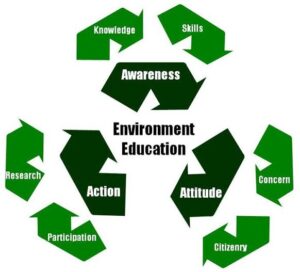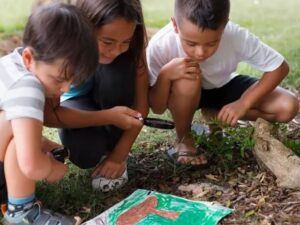Back to: Environmental Biology 300 Level
Welcome to class!
Have you ever wondered why people still throw plastic into gutters or burn waste even during harmattan? Often, it’s not because they don’t care—it’s because they don’t understand the consequences. That’s where environmental education and public awareness come in. When people are properly informed, they make better decisions for themselves, their communities, and the planet.
Environmental Education And Public Awareness
What is Environmental Education?
Environmental education is the process of teaching individuals and communities how their actions affect the environment and how they can make more responsible choices. It promotes understanding, values, attitudes, and skills that empower people to protect and improve their surroundings. It can happen in classrooms, churches, mosques, markets, TV programmes, and even during town hall meetings.

Goals of Environmental Education
To increase knowledge about environmental issues such as pollution, deforestation, and climate change
To develop skills for solving real-life environmental problems
To change behaviour towards more sustainable lifestyles
To encourage participation in environmental decision-making
To promote love, care, and respect for nature and community spaces
What is Public Environmental Awareness?
This refers to making environmental information available and accessible to the general public. It involves campaigns, media, school clubs, posters, social media, and community outreach. Public awareness helps people become conscious of the environment and inspires collective action.
Why Environmental Education and Public Awareness Matter
Informed Citizens: People become more conscious of how their actions impact nature

Community Participation: Local people get involved in planting trees, waste management, or fighting erosion
Policy Support: An informed public is more likely to support environmental laws and programmes
Cultural Shift: It helps replace harmful habits like open burning and littering with better practices
Youths as Leaders: Educated young people drive innovation in climate action and sustainability
Examples in Nigeria
Clean-Up Campaigns: Organisations like Let’s Do It Nigeria organise public sanitation drives in cities.
School Programmes: Many schools run environmental clubs supported by NGOs.
Media Campaigns: NTA, Channels TV, and radio stations sometimes feature shows on recycling or wildlife.
Faith-Based Messages: Religious leaders sometimes preach about the duty to protect God’s creation.
Social Media Influencers: Nigerian youths on platforms like Instagram and TikTok promote eco-friendly living.
Challenges in Nigeria
Low literacy levels in some rural areas
Limited funding for environmental education projects

Lack of government consistency in awareness efforts
Cultural resistance to change
Insufficient access to communication tools in some regions
Summary
- Environmental education teaches people how to live responsibly with nature.
- Public awareness helps spread this knowledge widely through media, schools, and communities.
- These tools empower people to take action and support environmental policies.
- Nigerian examples include clean-up campaigns, school clubs, and media outreach.
- Challenges include funding, low access, and resistance to change.
Evaluation
- What is environmental education?
- List two goals of environmental education.
- Mention two examples of public awareness activities in Nigeria.
- Why is youth involvement important in environmental education?
- List two challenges to environmental education in Nigeria.
Great job, champion! Remember, education is one of the strongest tools we have for protecting the environment. When you share what you’ve learned, you become part of the solution. Keep shining, keep learning, and know that Afrilearn believes in your power to make a difference!
